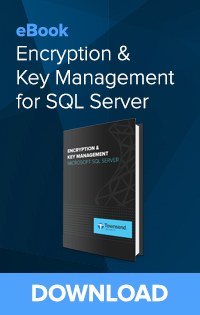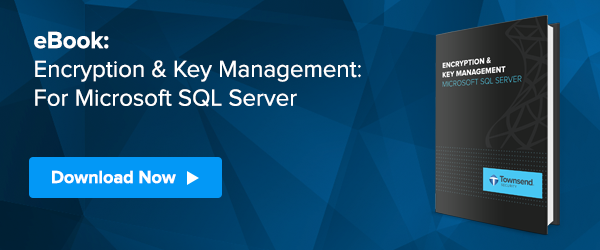Almost every organization has at least one application built on Microsoft’s SQL Server database. Whether you build an application in-house using Microsoft’s development tools or you deploy a software package from a software vendor, chances are that your organizations has one or more SQL Server databases to help you manage information.
The Challenge: Protect Data with SQL Server’s Encryption
 Today it is almost impossible to run a business without handling sensitive information and storing storing data such as customer names, credit card numbers, bank account numbers, passwords, email addresses, or other personally identifiable information (PII) or private health information (PHI) in your SQL Server database. If your organization must meet data security regulations such as PCI-DSS, HIPAA/HITECH, GLBA/FFIEC, or GDPR, you probably already know that this data must be encrypted in order to protect your customers and prevent data loss in the event of a data breach.
Today it is almost impossible to run a business without handling sensitive information and storing storing data such as customer names, credit card numbers, bank account numbers, passwords, email addresses, or other personally identifiable information (PII) or private health information (PHI) in your SQL Server database. If your organization must meet data security regulations such as PCI-DSS, HIPAA/HITECH, GLBA/FFIEC, or GDPR, you probably already know that this data must be encrypted in order to protect your customers and prevent data loss in the event of a data breach.
What you may not know is that in order to truly protect your data, you must manage your encryption keys in adherence to key management best practices such as dual control and separation of duties using an external encryption key manager (key managers are available in VMware, Cloud, as a traditional hardware security module or HSM). Your company will only be able to avoid data breach notification if you are using these best practices.
The good news is that Microsoft SQL Server comes equipped with transparent data encryption (TDE) and extensible key management (EKM) to make encryption and key management using a third-party key manager easier than ever. Older versions of SQL Server can also be easily encrypted using different tactics, and you can manage those encryption keys just as easily with an encryption key manager as well.
Encrypting Data in SQL Server Depends on Your Version
If you’re currently looking into encrypting your SQL Server database or deploying a key management system, you may be concerned about how to protect your data depending on the version, code, and language used to build your database. To help ease your worries, here are 4 ways to encrypt your SQL Server database and protect your encryption keys:
- Since SQL Server 2008 Enterprise and SQL Server 2019 Standard, Microsoft has supported automatic encryption with TDE and column-level encryption for Enterprise Edition users and above. Without any programming you can encrypt the SQL Server database or an individual column, and store the keys on an encryption key manager (commonly available as an HSM and in VMware or Cloud).
- If you have an older version of SQL Server, or you have SQL Server Standard Edition or Web Edition, you don’t have access to TDE. But you can still automate encryption: Through the strategic use of SQL Views and Triggers, you can automate encryption of sensitive data on your SQL Server without extensive program modifications, and still use a secure key manager to protect the encryption keys.
- Your developers might have written custom application code to implement your SQL Server database. But SQL Server encryption and key management is still within your reach. A good key management vendor should supply you with software libraries that easily add into your applications and implement SQL Server encryption.
- You might have a SQL Server database, but not be using Microsoft programming languages. Perhaps your applications are written in Java, Perl, or PHP. Again, it is simple to deploy software libraries that encrypt the SQL Server data and which store the encryption keys on an external centralized key manager.
SQL Server encryption and good key management is not difficult to achieve. Although key management has a reputation for being difficult and costly, today key management for SQL Server is cost-effective, easy, has little to no performance impact, will get your company in compliance, and will keep your organization out of the headlines by helping to prevent a data breach. Townsend Security's Alliance Key Manager is FIPS 140-2 compliant and in use by over 3,000 customers worldwide.
To learn more about key management for SQL Server, download the White Paper, “Encryption Key Management for Microsoft SQL Server.”

